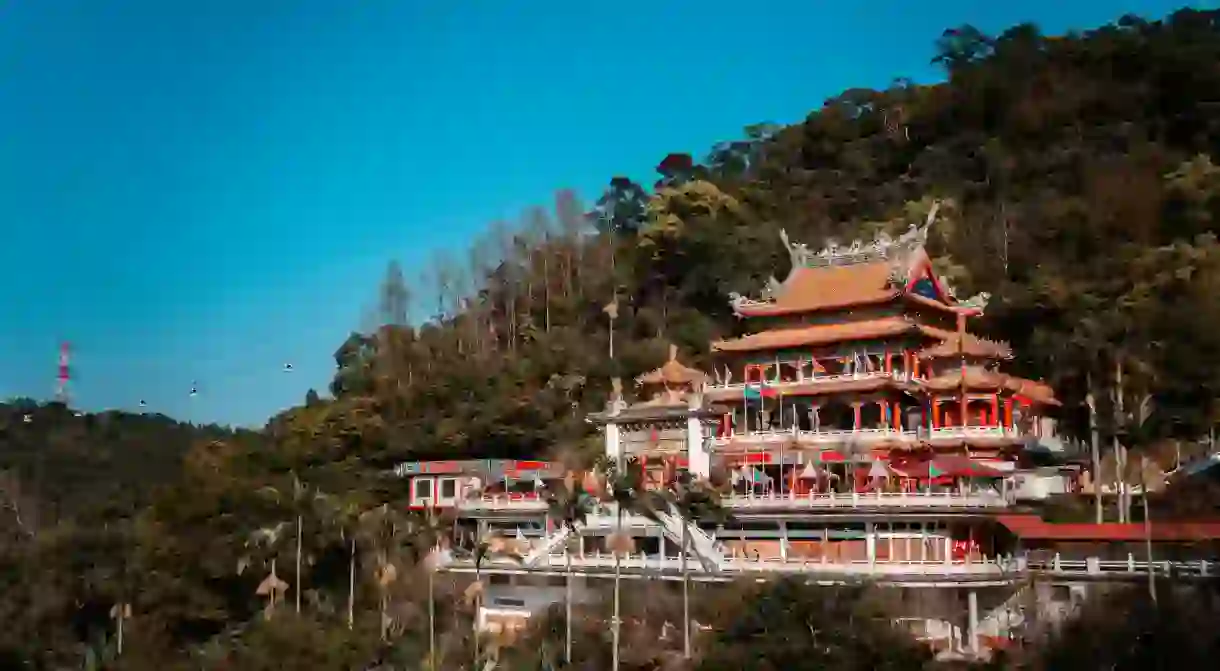How to Explore Maokong, Taipei's Tea Town

Steeped in terraces, temples and tea leaves, Maokong is Taipei’s tea tourism epicentre. A vertiginous valley split by the roaring Zhinan River, its dramatic scenery contrasts with the serenity of a cup of oolong in one of its famous teahouses. If you want to explore this part of Taiwan’s capital but don’t know where to start, this guide is for you.
The name oolong is derived from wulong, meaning “black dragon” in Mandarin. Relatively unknown in the West, oolong tea is partially oxidised and then roasted, which gives it a flavour profile somewhere between green and black tea. The two main varieties grown in Maokong are Tieguanyin – a jade-coloured floral tea – and Baozhong, a subtle, sweet tea with a pale golden colour said to resemble the full moon. Both are served in jitter-inducing quantities – perfect preparation for a hike on one of Maokong’s many scenic trails.
Getting there – hop on the Maokong Gondola
Architectural Landmark

Learn about Maokong's famous teas
Museum
One kilometre west of Maokong Station, the red-brick Taipei Tea Promotion Center has a display on tea growing, drying, spinning and roasting, as well as instructions on how to make the perfect brew. The best part? Free cups of Tieguanyin in the gift shop. The centre also runs tea picking, processing and brewing workshops from June through November.
Visit Zhinan Temple
Architectural Landmark, Historical Landmark

On returning from Maokong via the gondola, alight at Zhinan Station for the serene Zhinan Temple complex, which blends Taoist, Confucian and Buddhist elements. The biggest draw is the Chunyang Shrine dedicated to Lu Dong-bin, one of the “eight immortals” of Taoist tradition. The complex is most atmospheric at sunset, when thousands of paper lanterns bathe worshippers in their red glow.
Sample fried treats on Popular Food Street
The buzzing Popular Food Street is one of the first sights to greet visitors stepping off the gondola at Maokong Station. Try Taiwanese specialties such as bomb pancake – batter pressed into a circle, flipped onto a deep-fried egg and brushed with soy and chilli sauce. Skip the bubble tea and instead try grass jelly tea – sweet gelatinous cubes stirred up with black milk tea.

See spring flowers and local life on a hike
Awash with butterflies and spring blooms, Maokong is a hiker’s paradise. Choose one of the many shorter trails or stitch them together for a day’s worth of rambling. Pick up a map at Maokong Station before setting out, and load up on water and sunscreen – temperatures can reach 34C here.
Tread the Tea Fragrance Loop Trail
A combination of several smaller trails, the Tea Fragrance Loop Trail takes in terraced tea plantations and the Maokong Potholes – unusually pockmarked rocks in a tributary of the Zhinan River. The holes resemble cat paw prints, which give the Maokong area its name (Maokong means “cat’s hollows” in Mandarin).
Explore the Camphor and Zhanghu Trails
Slightly longer is the 1.2km (0.75mi) Camphor Trail, a gentle paved walkway that winds past charcoal kilns, granaries and clay-brick farmhouses. Among people from Taiwan, the trail is best known for the golden-yellow lupine flowers that bloom along its edges from February to April. The 2.5km (1.5mi) Zhanghu Trail, which runs almost parallel to the Camphor Trail, is a more secluded alternative.
Try the Zhinan Temple Trail
Either a gentle stroll or challenging climb depending on where you start, this trail begins on Zhinan Road and consists of 1,200 steps to Zhinan Temple. Those wishing to take the easier option can ride the gondola to the temple and walk downhill. From May to June, the trail is covered in white tung flowers known as “May snow” by locals.
Stop off at Ayishi Big Tea Pot
About an eight-minute walk from Maokong Station, Ayishi Big Tea Pot specialises in tea-based cuisine. Try tea-smoked chicken, noodles cooked in tea seed oil, and tea-infused stir-fried rice. The simply furnished dining room has views of the city and cable car line.
Experience Taiwanese teahouse culture
If you want the full Maokong tea experience, head to one of its teahouses for a lavish lunch. Tea is pricey, but you get plenty for your money – the dry leaves are brought over in a tin, and you can take away what you don’t use.
The lively 24-hour Yaoyue Teahouse is a 25-minute walk from Maokong Station. Plates are generous here – feast on mountains of dumplings, vegetable bao and ginger chicken. Enjoy the air-conditioning in the wood-panelled interior or snap photos of the valley from the outdoor terrace.
Elsewhere, ensconced among the hiking trails on Maokong’s west side is Zi Zai Tian, set in a remodelled traditional farmhouse with red-brick interiors, elegant dark wood furnishings and a bamboo-lined courtyard with latticed chairs. Food options are generally Western style: choose from sandwiches, waffles, muffins and brownies. Take a post-lunch stroll in the nearby Apricot Tree Garden, which is filled with cherry blossoms in January and peach blossoms in February.













